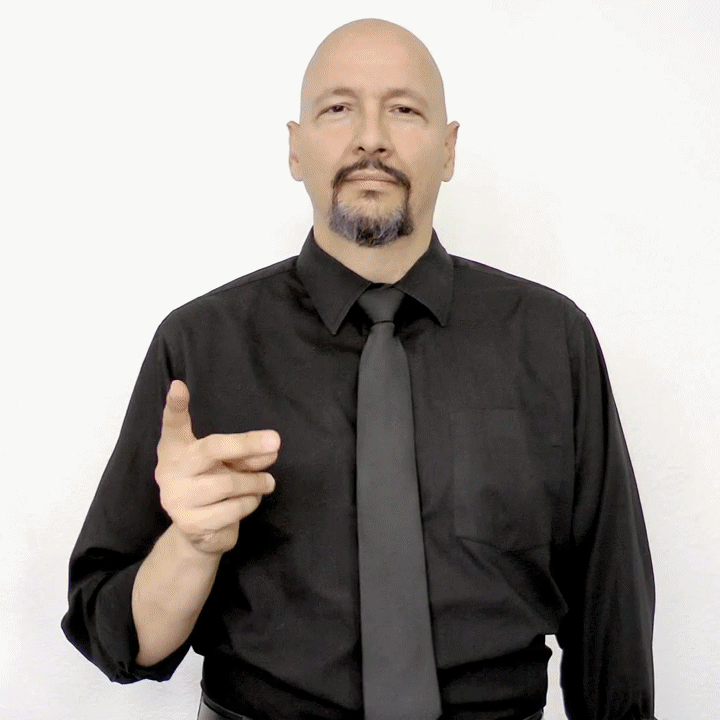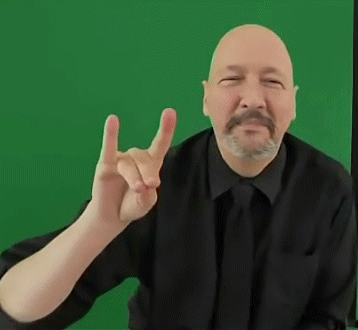DOG: The
American Sign Language (ASL) sign for "dog"
To sign DOG, just snap your fingers twice.
This is an interesting sign because it is sort of based on the fingerspelled
word D-O-G as well as the common gesture of snapping your fingers to get a
dog's attention. Note: The snap always uses the middle finger, not the index
finger. The beginning handshape looks a bit like a modified "D" hand and the
ending handshape winds up looking like the letter "G." Thus the sign sort of
looks like you are spelling the letters "DG" which creates a "lexicalized"
version of the fingerspelled word "D-O-G."
DOG:



Sample sentence: Do you have a dog and cat?
Notes:

There are several different "right" ways to
do the sign for dog.
A popular sign for "dog" is
made by slapping your right flat hand against your leg, then snapping your fingers. Or you can snap your fingers
once then slap your leg.
Or you can slap your leg twice and not snap your fingers at all.
My recommendation just use "lexicalized fingerspelling" method I describe above To do this, you fingerspell the letters "D" and "G" very quickly and "snap" the middle finger on the base of the thumb as you change from a modified "D" to a "G."
Here are some variations to show a dog barking:
CHIHUAHUA:

OPTIONAL READING / ADVANCED DISCUSSION:
In a message dated 1/14/2007 7:00:38 P.M. Pacific Standard Time, brittdun@gmail.com writes:
Good afternoon Dr. Bill,
My name is Brittany Dunlap. I am a hearing person who is dating a hearing impaired man named Roy. He went to school at the Ohio School for the Deaf. I have known him since May of 06, as friends, and we have been a couple since December. He is about 90% deaf and is progressively becoming more deaf as time passes. I am trying to learn ASL and he has promised to teach me (starting tomorrow) but I have been going through your lessons for the past few days now and have a question about the word "dog".
If you and a friend are sitting at a table signing, and you want to communicate the word "dog?" The leg slapping would be blocked by the table. Would you improvise and slap your abdomen? Or would your friend be totally confused by that? Or does that have a totally different meaning? Is there any way around that situation, other than fingerspelling dog?
Many thanks,
Brittany D.
Grove City, OH 43123-9084brittdun@
Brittany,
Hello :)
The sign DOG actually has five variations. Oh, sure, people will tell
you THEIR version is right.
Just smile sweetly and nod.
If the person is your sign instructor then do it his or her way for
however long your class is. (Heh.)
The
main
versions of "DOG" are:
1. Snap your fingers twice.
2. Snap your fingers
once.
3. Slap your thigh twice.
4. Snap your fingers once and then slap your thigh once.
5. Slap your thigh once and then snap your fingers.
In your situation due to the table, the obvious choice is to use the
version that doesn't require hitting your leg.
If I were you, I'd use the snap" version
of #DOG.
A cool thing I want to point out is that the snap in this case is actually
what we call "lexicalized" fingerspelling. Start with a modified "D" handshape
(with just the middle finger touching the thumb and the index finger
extended) and snap your middle finger and end up in a "G" handshape.
(Lexicalization means "the process of becoming like a lexeme." The word
"lexeme" means basic root words. So, what we are saying is that the
fingerspelling no longer looks or functions like typical fingerspelling,
it has changed to become like a "word" or sign.)
As an adult communicating with other skilled adults I generally just sign
D-G (with a double snap). But on the other hand, when communicating with a young child I sometimes switch to the double-leg
pat.
A Deaf coworker of mine has a pet peeve
regarding students (and instructors) who sign "DOG" in a redundant manner
(using both the snap and the pat). He doesn't like it a bit.
I can
understand his point of view, but I also think it is important to be
flexible. For example, one of my daughters, Sarah, has no joints in her fingers and thus can't
really do fingerspelling or "snapping." Guess which version of "dog" she
prefers?
Cordially,
-- Dr.
Bill
Hi Dr. Vicars--
I am learning some ASL to sign with my (hearing) baby. Another friend with an older child also signs with her (also hearing) baby. She uses an alternate sign for "dog" instead of the snap and leg tap, it's basically sticking her tongue out a bit and panting like a dog. She swears this is a legit ASL alternative, but I can't find it anywhere. Most baby sign language teachers encourage families to modify signs as needed or even go with signs their babies make up spontaneously, since the goal is for baby to be able to communicate with caregivers and family, rather than the Deaf community. I'm curious, though, for the "official" stance on this alternate for "dog"? Thanks much!
Richelle Johnson
Richelle,
It is likely that the only time you might see such a sign
used to mean "dog" in "ASL" would be during story-time for
very young children.
A skilled signer might mime and/or role-play being a dog as part of
an entertaining skit or storytelling event for kids.
During a typical conversation between two adult Deaf signers you are
not going to see one of them sticking
their tongue out and panting as a way of signing "dog." I suppose I
might use that sign to mean "panting" if I wanted to tell my wife
that our dog was "panting like crazy" after having taken her (the
dog, not the wife) out for a run. In such a situation I would be
actually be using the "PANTING" sign to mean "panting" and not to
mean "dog."
Cordially,
- Dr. Bill
p.s.
Taking the wife out for a run would involve other signs such
as HEART-ATTACK and AMBULANCE.
Additionally, if someday she reads this - there will be signs
such as ASSAULT and DIVORCE. Heh.
Question:
Why are there variations of signs for the same words? Like dog or cat.
Answer:
ASL signs have variations for the same reason that English words have
variations.
For example, in English a dog is sometimes called doggy, hound, mongrel,
mutt, pooch, stray, bowwow, pup, puppy, cur, fido, flea bag, man's best
friend, etc.
All languages have vocabulary variations and versions.
I'm sure if you think about it, or use a thesaurus you can come up with
several English word variations that mean "cat."
If you want to learn more animal signs, check out:
Notes:
See: ANIMAL
*
Want to help support ASL University? It's easy:
* Another way to help is to buy something from Dr. Bill's "Bookstore."
* Want even more ASL resources? Visit the "ASL Training Center!" (Subscription
Extension of ASLU)
* Also check out Dr. Bill's channel:
www.youtube.com/billvicars
You can learn American Sign Language (ASL) online at American Sign Language University ™
ASL resources by Lifeprint.com © Dr. William Vicars